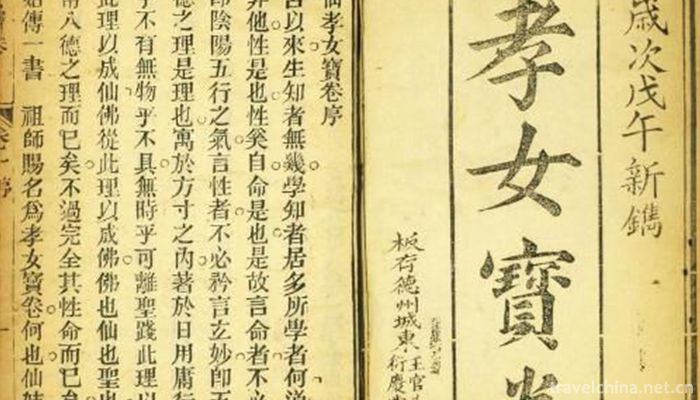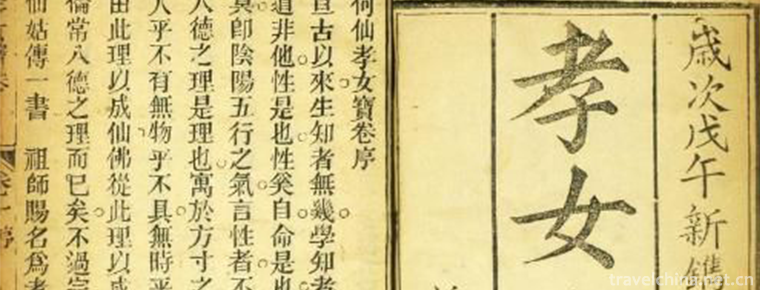Treasure roll
Treasure roll
Baojuan is a traditional Chinese literary form of rap and singing, which evolved from the folklore in the temples of Tang Dynasty. Most of the authors are monks and nuns. There are Buddhist Scripture stories, persuasive texts, Shinto stories and folk stories, with the most Buddhist Scripture stories. People tend to divide them into Buddhist and non-Buddhist categories, but the basic tendency is to propagate the cause and effect of karma and to live in the world with a strong religious color. The present "Fragrant Mountain Treasure Scroll" is generally considered to be the work of monks of Song Puming. Since the Ming and Qing Dynasties, the treasure rolls based on Chinese folk tales have become increasingly popular. More than 200 kinds of "Liangshan Bobao Volume" and "Pharmaceutical Name Bao Volume" are known to later generations. Formally, seven-character and ten-character verses are the main ones, while prose is the main one. The language is vivid, popular and lively, and has strong artistic appeal.
characteristic
Baojuan is a folk rap script that preaches religious doctrines. The use of popular literature combined with rap and singing to propagate religious doctrines and regulations has appeared in the popular lectures and variants of the Tang Dynasty, and later influenced by the Song Dynasty's Sutras, Zhugong tunes and drum ci, which has been named Baojuan since the Ming Dynasty. Baojuan can be divided into two categories: telling and singing scriptures and singing Buddhist stories. Because of its simplicity and popularity, it has become a classic of folk religions (such as Bailian religion and Hongyang religion). In the four years of Ming Zhengde (1509), Luo Menghong's five and six volumes were printed and published, and various sects followed suit. In the Wanli and Chongzhen years, the publication peak of the volumes was formed. Folk religious believers regard treasure scrolls as precious and sacred. Most of the precious scrolls are beautifully printed and decorated, just like orthodox religious classics. The remaining precious scrolls are precious materials for understanding and studying folk religious beliefs. After the reign of Qingdaoguang, there were two trends in the contents of Baojuan: one was still a religious lesson and doctrine, i.e. the one of "Fu Meng Tong Shen Jiang Tuan" and the other was gradually getting rid of the religious atmosphere, mainly by telling and singing myths, legends and folk stories, which became a form of folk art, such as "Wuzu Huang Mei Baojuan", "Han Xiangbao Juan Baojuan", "Bai Snake Zhuan Baojuan Baojuan" and "Meng Jiangnu Baojuan".
Development
One is written communication, the other is oral communication.
The stories of Baojuan are longer, the shortest is 56,000 words, and the longest is 89,000 words. The local people think that copying is the accumulation of merits and virtues, and people with culture are willing to copy. Copy their own preservation, you can also give friends and relatives. The illiterate person invites others to copy and relies on it to avoid evil spirits. There are also a few precious scrolls which are woodcut and lithographic. The most basic way of spreading treasure rolls is to spread them.
Baojuan came into being in a large number in Ming and Qing dynasties and was prevalent in many parts of the country. In the vast countryside of Hexi area in Gansu Province, Baojuan still has a strong vitality. Every year around the Spring Festival and during the idle season of agriculture, many rural areas hold grand "roll-out" activities, thus preserving a large number of hand-written books as the main treasure rolls. Over the past decade, some folk literary and art enthusiasts have gone deep into the rural areas of Hexi to investigate and dig out, initially sorted out the distribution, preservation and publication of Hexi Baojuan, and published a number of Baojuan.
content
The treasure rolls circulated in Hexi area are not only of various kinds, but also of distinctive content. The contents of the treasure rolls are mostly to suppress evil and promote good. They can not only enlighten and persuade people to conduct themselves, but also create a lively atmosphere, giving people emotional pleasure or spiritual enlightenment. Rural people generally regard it as the standard of making a statement, establishing morality and establishing a product, and regard it as "a treasure in the family, and there is no taboo in everything". Some regard it as a timely rain with good weather and plentiful grain, some as a selfless stick to punish evil and uphold justice, and some as a treasure book of loyalty, filial piety, benevolence and peace. Some families are unfilial to their children, wives are not good, family affairs are not good, people are not in harmony, with the way of "read treasure rolls" so that their families are educated, regret. Baojuan has the deepest foundation, the greatest influence and the widest scope among the people in Hexi. The rhyme sentences in Baojuan are mostly cross sentences, followed by seven-character sentences, five-character sentences and four-character sentences, which have a certain level rhythm. Of course, the number of sentences can also be flexible, the longest can be up to 30 sentences, the shorter only 4 sentences. The rhyme is accompanied by tunes, whose tunes not only retain some of the original tunes, but also use a large number of local folk tunes. According to preliminary statistics, there are more than 20 kinds of tunes, such as lotus drop, beating Palace tune, wave wash sand, crying, etc. The use of these tunes, there are no strict regulations and restrictions, the candidates can flexibly arrange according to the development of the plot, and the content can be changed at any time. Fresh blood is often injected into the treasure rolls to keep the tune young and beautiful. In this way, the whole scroll will be lively from beginning to end, singing, reading, talking, reading and singing. The audience was very attentive and enthusiastic, staying up all night.


-
1.Mount Tianzhu Scenic Area
Tianzhu Mountain Scenic Spot, located in the west of Qianshan City, Anqing City, Anhui Province, is known as "the first mountain in the Yangtze River and Huaihe River" for its main peak
Time 2018-12-08 -
2.Engraving Printing Skills
Engraving printing technology, Yangzhou City, Jiangsu Province, local traditional handicraft, one of the national intangible cultural heritage.
Time 2019-04-27 -
3.Kirgiz costumes
"Kirgiz" means the people who live on the cliffs. Another saying is that "Kirgiz" are forty girls. This statement is wrong. Most of the Kirgiz people live in Xinjiang's Kizilesu Au
Time 2019-05-09 -
4.Tune in the sea
Linhai Ci Tune, also known as Taizhou Ci Tune, Talent Ci Tune and Xianhe Tune, is developed from Nanci, Kunqu and Taizhou local folk minor. It is one of the folk songs of Taizhou, Zhejiang Province. I
Time 2019-05-13 -
5.Salar Folk Songs
There are many kinds of Salar folk songs. In the course of long-term historical development, they have formed colorful and distinctive musical forms and singing styles. Salar folk songs keep the ancie
Time 2019-06-12 -
6.Sangzhi Folk Song
Sangzhi folk song originated from the ballads of the ancestors'daily production and life in the primitive farming period. It is a kind of folk music culture created, Sung and accumulated by the people
Time 2019-06-12 -
7.Bamboo weaving in Shengzhou
Shengzhou bamboo weaving is one of the traditional handicraft products in Shengzhou, Zhejiang Province. Shengzhou bamboo weaving technology is distributed in the bamboo producing areas of the city, in
Time 2019-06-14 -
8.Eighteen Butterflies
Eighteen butterflies is a local traditional dance form popular in the central part of Zhejiang Province (mainly in the area of Jinhua Yongkang). Twenty young women play the whole set of eighteen butte
Time 2019-06-15 -
9.Guangdong embroidery
Guangdong embroidery is the general name of Guangzhou embroidery (Guangzhou embroidery) and Chaozhou embroidery (Chaozhou embroidery). It is one of the four famous embroidery in China.
Time 2019-07-16 -
10.West Anhui University
West Anhui University (West Anhui University) was the 3 menstrual period of 2000. Ministry of Education Approved provincial comprehensive Undergraduate Colleges From the original West Anhui United Uni
Time 2019-11-20 -
11.Wenshu Temple
Wenshu Temple is located in Qingyang District of Chengdu City. It was founded in the Daye period of Sui Dynasty (605-617). In 1697, the 36th year of Kangxi raised funds to rebuild the temple, which was renamed Wenshu courtyard.
Time 2020-10-18 -
12.Natural disasters in Mianyang
Earthquake: Mianyang City is located in the western mountain area, namely Pingwu, Beichuan and Anxian mountains, and the Northwest Mountainous Area of Jiangyou, which is one of the earthquake prone areas in Sichuan Province.
Time 2020-12-14